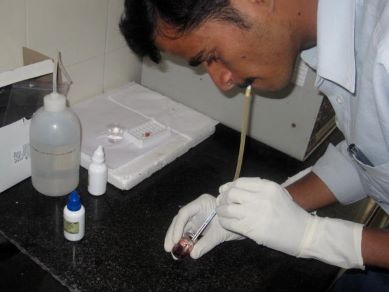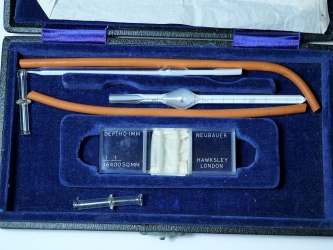The technique of ‘mouth pipetting’ – literally using your mouth to suck up and release blood or liquids into another vessel - was common in laboratories right up until the 1970s. It was also unsurprisingly the leading cause of laboratory-based infections and is now banned.
The hazards of the technique were clear early on: the ‘first recorded laboratory infection due to mouth pipetting occurred in 1893…[with] the case of a physician who accidentally sucked a culture of typhoid bacilli into his mouth’. Dr Eric Watts recalled that in his early years in the profession ‘many haematologists learned the hard way how to obtain a gentle degree of suction to get just the right amount of blood’.

Credit: A short stint in India blogspot

Neubauer counting chamber 1922
© L A Parapia
Dr Watts has written an account of his first observation the technique as a patient aged 14 in 1962:
‘My earliest recollection of a hospital laboratory was when I was being treated for a neuroblastoma and would go in for blood tests and injections.
On the wards, the blood tests involved a stern-faced woman arriving with her toolbox, from which she would take a stylette to jab my finger. She would then suck up the blood in a pipette through a rubber tube. She placed the pipette into a jar of diluting fluid and would then suck this up into the mixing chamber.
This done, she would expel the blood and diluent into a further jar for counting in the lab where the mixture would go into a Neubauer counting chamber in a glass slide for a manual cell count’.
Dr Watts continues his story:
‘Later on, as an outpatient I went to the lab to have blood tests and injections of combination chemotherapy. It was a fascinating place with steam rising out of the sterilisers for the glass syringes and the ether-like smell of the antiseptic rub prior to the venepuncture. Packed with benches, microscopes and water baths, there was a small corner where I would sit, next to the steriliser holding the reusable needles and glass syringes, sometimes the needles would be re-sharpened before use. On busy days it became quite steamy with the sterilisers in frequent use.’
Sources:
- https://incubator.rockefeller.edu/origins-of-the-pipette-why-todays-scientists-dont-need-to-use-their-mouths/
- A Short Stint in India (http://shortstintinindia.blogspot.com/)
- https://bodyhorrors.wordpress.com/2013/03/20/mouth_pipetting/
- Pleasures and perils of working in the old lab by E Watts, ACP news (The Association of Clinical Pathologists), Winter 2019; 51-52

